River Radii: A Comparative National Framework for Remote Monitoring of Environmental Change at River Mouths
Abstract
:1. Introduction
Objectives
2. Materials and Methods
2.1. River Radii (RR) Sampling Framework
2.1.1. River End Point Dataset
2.1.2. Coastline Geometry
2.2. Satellite Remote Sensing (SRS) Data
2.2.1. Data Products
Kd490: ESA OC-CCI 4 km Product
KdPAR: NIWA SCENZ 500 m Product
2.2.2. Data Extraction and Statistical Tests
3. Results
3.1. Radius of River Influences
3.2. Influence of Coastal Hydrosystem Types and Coastline Geometry at River Mouths
3.2.1. Coastal Hydrosystem Influences
3.2.2. Coastline Geometry
3.3. Case Studies
3.3.1. Influence of Stream Order and Catchment
3.3.2. Differences Across Marine Bioregions
3.3.3. Remote Monitoring of Environmental Changes
4. Discussion
4.1. Contributions of a Proximity-Based Framework
4.2. Optimum Sampling Radius
4.3. Effects of Data Resolution and Coastline Geometry
4.4. Applications and Future Directions
Supplementary Materials
Author Contributions
Funding
Data Availability Statement
Acknowledgments
Conflicts of Interest
Appendix A
| Coastline Geometry Class | Coastal Hydrosystem Class † | Description | n |
|---|---|---|---|
| Open coast | Tidal river | Rivers and streams that have a permanent connection to the sea that is facilitated by a permanent subtidal channel through the shoreline/beach formation that allows regular saltwater inputs in the tidal cycle. These river mouths often form narrow basins that are maintained by the interplay between outgoing river discharges and incoming tidal forcing. In deeper systems, they can form stratified salinity layers where the outflowing freshwater overlays a denser layer of seawater in the absence of mixing. | 83 |
| Freshwater river | Rivers and streams that have a permanent connection to the sea that is formed by flows sufficient to cut a persistent subtidal channel through the beach formation. The channel gradient is typically steep enough to prevent saltwater intrusion, although tidal backwater effects may still be observed in the lower river. | 21 | |
| Beach stream | Occurs where a shallow stream flows over the beach face to the sea. This differs from a river where the larger flow cuts a subtidal channel through the beach face. | 17 | |
| Tidal lagoon | Circular to elongated basins that are enclosed by a sand spit or similar barrier with a permanent and typically narrow entrance to the sea that is often associated with ebb and flood tidal delta formations. These lagoons are generally shallow with an extensive intertidal area and strong tidal current flows through the entrances and major channels. River inputs are small compared to the tidal inflow except during flood events. Although the entrance position may be stable, the barrier spit may be breached during flood or high wave events, leading to the formation of new entrances. | 36 | |
| Waituna-type lagoon | Coastal lagoons that are generally shallow and separated from the sea by a barrier or barrier beach. The lagoon is typically a freshwater or slightly brackish waterbody that may vary spatially and temporally, with drainage to the sea occurring by percolation through the barrier and occasional lagoon openings. These may occur in storm events associated with wave overtopping or when lagoon water levels have sufficient hydraulic head to breach the barrier. | 6 | |
| Hāpua-type lagoon | Non-tidal river mouth lagoons that are generally elongated, narrow, shallow, and oriented parallel to the coastline. The enclosing barrier on their ocean boundary is typically formed by coarse clastic materials that are shaped by strong longshore sediment transport and pushed up by high-wave-energy environments. There is usually no tidal inflow due to the higher (perched) elevation of the lagoon relative to the tidal range, although saltwater intrusion may occur periodically with storm surge or extreme tide events or through the overtopping of the barrier in large swell events. | 24 | |
| Enclosed coast | Shallow drowned valley | Shallow drowned valley systems often have an extensive intertidal area with complex dendritic shorelines leading off a main central basin or channel. Differences between shallow drowned valleys and tidal lagoons include their greater mean depth, which in combination with their planform complexity, results in less tidal flushing. | 23 |
| Deep drowned valley | Deep, mostly subtidal systems that are typically formed by the partial submergence of an unglaciated river valley. The shoreline complexity is inherited from the drainage pattern of the flooded river valley. Both river and tidal inputs over the tidal cycle are small proportions of the total basin volume. Longitudinal gradients in hydrodynamic processes may be present with riverine forcing and stratification dominating in the inner reaches and more dominant tidal forcing towards the open ocean. | 10 | |
| Fiord | Narrow and very deep coastal basins with steep sides or cliffs, formed in glacial valleys flooded by the sea following the last glacial period. The basin is predominately subtidal, with only small intertidal areas in the upper reaches. A sill may be present in various positions with the fiord, which reflects the position of previous glacial moraines. River and tidal inputs are small in proportion to the total basin volume, but a substantial freshwater layer can form due to the stratification of the water column. | 6 | |
| Total | 226 |
References
- Cicin-Sain, B.; Knecht, R. Integrated Coastal and Ocean Management: Concepts and Practices; Island Press: Washington, DC, USA, 2013. [Google Scholar]
- Côté, I.M.; Darling, E.S.; Brown, C.J. Interactions among ecosystem stressors and their importance in conservation. Proc. R. Soc. B Biol. Sci. 2016, 283, 20152592. [Google Scholar] [CrossRef] [PubMed]
- Crain, C.M.; Kroeker, K.; Halpern, B.S. Interactive and cumulative effects of multiple human stressors in marine systems. Ecol. Lett. 2008, 11, 1304–1315. [Google Scholar] [CrossRef] [PubMed]
- Álvarez-Romero, J.G.; Pressey, R.L.; Ban, N.C.; Vance-Borland, K.; Willer, C.; Klein, C.J.; Gaines, S.D. Integrated land-sea conservation planning: The missing links. Annu. Rev. Ecol. Evol. Syst. 2011, 42, 381–409. [Google Scholar] [CrossRef]
- Polasky, S.; Carpenter, S.R.; Folke, C.; Keeler, B. Decision-making under great uncertainty: Environmental management in an era of global change. Trends Ecol. Evol. 2011, 26, 398–404. [Google Scholar] [CrossRef]
- Andersen, J.H.; Al-Hamdani, Z.; Harvey, E.T.; Kallenbach, E.; Murray, C.; Stock, A. Relative impacts of multiple human stressors in estuaries and coastal waters in the North Sea–Baltic Sea transition zone. Sci. Total Environ. 2020, 704, 135316. [Google Scholar] [CrossRef]
- Halpern, B.S.; Frazier, M.; Afflerbach, J.; Lowndes, J.S.; Micheli, F.; O’Hara, C.; Scarborough, C.; Selkoe, K.A. Recent pace of change in human impact on the world’s ocean. Sci. Rep. 2019, 9, 11609. [Google Scholar] [CrossRef]
- Hodapp, D.; Roca, I.T.; Fiorentino, D.; Garilao, C.; Kaschner, K.; Kesner-Reyes, K.; Schneider, B.; Segschneider, J.; Kocsis, Á.T.; Kiessling, W.; et al. Climate change disrupts core habitats of marine species. Glob. Change Biol. 2023, 29, 3304–3317. [Google Scholar] [CrossRef]
- IPCC. Climate Change 2023: Synthesis Report. Contribution of Working Groups I, II and III to the Sixth Assessment Report of the Intergovernmental Panel on Climate Change; IPCC: Geneva, Switzerland, 2023. [Google Scholar]
- Abell, R. Conservation biology for the biodiversity crisis: A freshwater follow-up. Conserv. Biol. 2002, 16, 1435–1437. [Google Scholar] [CrossRef]
- Halpern, B.S.; Walbridge, S.; Selkoe, K.A.; Kappel, C.V.; Micheli, F.; D’Agrosa, C.; Bruno, J.F.; Casey, K.S.; Ebert, C.; Fox, H.E.; et al. A global map of human impact on marine ecosystems. Science 2008, 319, 948–952. [Google Scholar] [CrossRef]
- Albert, J.S.; Destouni, G.; Duke-Sylvester, S.M.; Magurran, A.E.; Oberdorff, T.; Reis, R.E.; Winemiller, K.O.; Ripple, W.J. Scientists’ warning to humanity on the freshwater biodiversity crisis. AmBio 2020, 50, 85–94. [Google Scholar] [CrossRef]
- Barbier, E.B.; Hacker, S.D.; Kennedy, C.; Koch, E.W.; Stier, A.C.; Silliman, B.R. The value of estuarine and coastal ecosystem services. Ecol. Monogr. 2011, 81, 169–193. [Google Scholar] [CrossRef]
- Lopez-Rivas, J.D.; Cardenas, J.-C. What is the economic value of coastal and marine ecosystem services? A systematic literature review. Mar. Policy 2024, 161, 106033. [Google Scholar] [CrossRef]
- Seitz, R.D.; Wennhage, H.; Bergström, U.; Lipcius, R.N.; Ysebaert, T. Ecological value of coastal habitats for commercially and ecologically important species. ICES J. Mar. Sci. 2013, 71, 648–665. [Google Scholar] [CrossRef]
- Jonsson, P.R.; Hammar, L.; Wåhlström, I.; Pålsson, J.; Hume, D.; Almroth-Rosell, E.; Mattsson, M. Combining seascape connectivity with cumulative impact assessment in support of ecosystem-based marine spatial planning. J. Appl. Ecol. 2021, 58, 576–586. [Google Scholar] [CrossRef]
- Foley, M.M.; Mease, L.A.; Martone, R.G.; Prahler, E.E.; Morrison, T.H.; Murray, C.C.; Wojcik, D. The challenges and opportunities in cumulative effects assessment. Environ. Impact Assess. Rev. 2017, 62, 122–134. [Google Scholar] [CrossRef]
- Álvarez-Romero, J.G.; Devlin, M.; Teixeira da Silva, E.; Petus, C.; Ban, N.C.; Pressey, R.L.; Kool, J.; Roberts, J.J.; Cerdeira-Estrada, S.; Wenger, A.S.; et al. A novel approach to model exposure of coastal-marine ecosystems to riverine flood plumes based on remote sensing techniques. J. Environ. Manag. 2013, 119, 194–207. [Google Scholar] [CrossRef]
- Restrepo, J.D.; Park, E.; Aquino, S.; Latrubesse, E.M. Coral reefs chronically exposed to river sediment plumes in the southwestern Caribbean: Rosario Islands, Colombia. Sci. Total Environ. 2016, 553, 316–329. [Google Scholar] [CrossRef]
- Devlin, M.J.; McKinna, L.W.; Álvarez-Romero, J.G.; Petus, C.; Abott, B.; Harkness, P.; Brodie, J. Mapping the pollutants in surface riverine flood plume waters in the Great Barrier Reef, Australia. Mar. Pollut. Bull. 2012, 65, 224–235. [Google Scholar] [CrossRef]
- Petus, C.; da Silva, E.T.; Devlin, M.; Wenger, A.S.; Álvarez-Romero, J.G. Using MODIS data for mapping of water types within river plumes in the Great Barrier Reef, Australia: Towards the production of river plume risk maps for reef and seagrass ecosystems. J. Environ. Manag. 2014, 137, 163–177. [Google Scholar] [CrossRef]
- Beck, M.W.; Heck, K.L.; Able, K.W.; Childers, D.L.; Eggleston, D.B.; Gillanders, B.M.; Halpern, B.; Hays, C.G.; Hoshino, K.; Minello, T.J.; et al. The identification, conservation, and management of estuarine and marine nurseries for fish and invertebrates: A better understanding of the habitats that serve as nurseries for marine species and the factors that create site-specific variability in nursery quality will improve conservation and management of these areas. Bioscience 2001, 51, 633–641. [Google Scholar] [CrossRef]
- Elliott, M.; Whitfield, A.K. Challenging paradigms in estuarine ecology and management. Estuar. Coast. Shelf Sci. 2011, 94, 306–314. [Google Scholar] [CrossRef]
- Orchard, S. Cultural ecosystem services and the natural capital of nature-based recreation and fisheries. In Routledge Handbook of Cultural Ecosystem Services; McElwee, P., Ed.; Routledge: London, UK, 2025. [Google Scholar]
- Schiel, D.R.; Howard-Williams, C. Controlling inputs from the land to sea: Limit-setting, cumulative impacts and ki uta ki tai. Mar. Freshw. Res. 2016, 67, 57–64. [Google Scholar] [CrossRef]
- Kroon, F.J.; Kuhnert, P.M.; Henderson, B.L.; Wilkinson, S.N.; Kinsey-Henderson, A.; Abbott, B.; Brodie, J.E.; Turner, R.D.R. River loads of suspended solids, nitrogen, phosphorus and herbicides delivered to the Great Barrier Reef lagoon. Mar. Pollut. Bull. 2012, 65, 167–181. [Google Scholar] [CrossRef] [PubMed]
- Geyer, W.R.; Hill, P.S.; Kineke, G.C. The transport, transformation and dispersal of sediment by buoyant coastal flows. Cont. Shelf Res. 2004, 24, 927–949. [Google Scholar] [CrossRef]
- Restrepo, J.D.; Zapata, P.; Díaz, J.M.; Garzón-Ferreira, J.; García, C.B. Fluvial fluxes into the Caribbean Sea and their impact on coastal ecosystems: The Magdalena River, Colombia. Glob. Planet. Change 2006, 50, 33–49. [Google Scholar] [CrossRef]
- Moreno-Madriñán, M.J.; Rickman, D.L.; Ogashawara, I.; Irwin, D.E.; Ye, J.; Al-Hamdan, M.Z. Using remote sensing to monitor the influence of river discharge on watershed outlets and adjacent coral Reefs: Magdalena River and Rosario Islands, Colombia. Int. J. Appl. Earth Obs. Geoinf. 2015, 38, 204–215. [Google Scholar] [CrossRef]
- Yang, H.; Kong, J.; Hu, H.; Du, Y.; Gao, M.; Chen, F. A review of remote sensing for water quality retrieval: Progress and challenges. Remote Sens. 2022, 14, 1770. [Google Scholar] [CrossRef]
- McCarthy, M.J.; Colna, K.E.; El-Mezayen, M.M.; Laureano-Rosario, A.E.; Méndez-Lázaro, P.; Otis, D.B.; Toro-Farmer, G.; Vega-Rodriguez, M.; Muller-Karger, F.E. Satellite remote sensing for coastal management: A review of successful applications. Environ. Manag. 2017, 60, 323–339. [Google Scholar] [CrossRef]
- Bhargava, A.; Sachdeva, A.; Sharma, K.; Alsharif, M.H.; Uthansakul, P.; Uthansakul, M. Hyperspectral imaging and its applications: A review. Heliyon 2024, 10, e33208. [Google Scholar] [CrossRef]
- Sharaf El Din, E.; Yun, Z.; and Suliman, A. Mapping concentrations of surface water quality parameters using a novel remote sensing and artificial intelligence framework. Int. J. Remote Sens. 2017, 38, 1023–1042. [Google Scholar] [CrossRef]
- Jaywant, S.A.; Arif, K.M. Remote sensing techniques for water quality monitoring: A review. Sensors 2024, 24, 8041. [Google Scholar] [CrossRef] [PubMed]
- Mohseni, F.; Saba, F.; Mirmazloumi, S.M.; Amani, M.; Mokhtarzade, M.; Jamali, S.; Mahdavi, S. Ocean water quality monitoring using remote sensing techniques: A review. Mar. Environ. Res. 2022, 180, 105701. [Google Scholar] [CrossRef] [PubMed]
- Gattuso, J.P.; Gentili, B.; Antoine, D.; Doxaran, D. Global distribution of photosynthetically available radiation on the seafloor. Earth Syst. Sci. Data 2020, 12, 1697–1709. [Google Scholar] [CrossRef]
- Kim, Y.J.; Daehyeon, H.; Eunna, J.; Jungho, I.; and Sung, T. Remote sensing of sea surface salinity: Challenges and research directions. GIScience Remote Sens. 2023, 60, 2166377. [Google Scholar] [CrossRef]
- Merchant, C.J.; Embury, O.; Bulgin, C.E.; Block, T.; Corlett, G.K.; Fiedler, E.; Good, S.A.; Mittaz, J.; Rayner, N.A.; Berry, D.; et al. Satellite-based time-series of sea-surface temperature since 1981 for climate applications. Sci. Data 2019, 6, 223. [Google Scholar] [CrossRef]
- Minnett, P.J.; Alvera-Azcárate, A.; Chin, T.M.; Corlett, G.K.; Gentemann, C.L.; Karagali, I.; Li, X.; Marsouin, A.; Marullo, S.; Maturi, E.; et al. Half a century of satellite remote sensing of sea-surface temperature. Remote Sens. Environ. 2019, 233, 111366. [Google Scholar] [CrossRef]
- Vos, K.; Splinter, K.D.; Palomar-Vázquez, J.; Pardo-Pascual, J.E.; Almonacid-Caballer, J.; Cabezas-Rabadán, C.; Kras, E.C.; Luijendijk, A.P.; Calkoen, F.; Almeida, L.P.; et al. Benchmarking satellite-derived shoreline mapping algorithms. Commun. Earth Environ. 2023, 4, 345. [Google Scholar] [CrossRef]
- Zhao, Q.; Pan, J.; Devlin, A.T.; Tang, M.; Yao, C.; Zamparelli, V.; Falabella, F.; Pepe, A. On the exploitation of remote sensing technologies for the monitoring of coastal and river delta regions. Remote Sens. 2022, 14, 2384. [Google Scholar] [CrossRef]
- Xu, N.; Ma, Y. Satellite remote sensing based coastal bathymetry inversion. In Current Trends in Estuarine and Coastal Dynamics, Wang, X.H., Qiao, L., Mitchell, S., Elliott, M., Eds.; Elsevier: Amsterdam, The Netherlands, 2024; Volume 4, pp. 45–73. [Google Scholar]
- Jawak, S.; Vadlamani, S.; Luis, A. A synoptic review on deriving bathymetry information using remote sensing technologies: Models, methods and comparisons. Adv. Remote Sens. 2015, 4, 147–162. [Google Scholar] [CrossRef]
- Kuenzer, C.; Heimhuber, V.; Huth, J.; Dech, S. Remote sensing for the quantification of land surface dynamics in large river delta regions—A review. Remote Sens. 2019, 11, 1985. [Google Scholar] [CrossRef]
- Raffa, F.; Alberico, I.; Serafino, F. X-band radar system to detect bathymetric changes at river mouths during storm surges: A case study of the Arno River. Sensors 2022, 22, 9415. [Google Scholar] [CrossRef] [PubMed]
- Sheffield, J.; Wood, E.F.; Pan, M.; Beck, H.; Coccia, G.; Serrat-Capdevila, A.; Verbist, K. Satellite remote sensing for water resources management: Potential for supporting sustainable development in data-poor regions. Water Resour. Res. 2018, 54, 9724–9758. [Google Scholar] [CrossRef]
- Adjovu, G.E.; Stephen, H.; James, D.; Ahmad, S. Overview of the application of remote sensing in effective monitoring of water quality parameters. Remote Sens. 2023, 15, 1938. [Google Scholar] [CrossRef]
- Schaeffer, B.A.; Schaeffer, K.G.; Keith, D.; Lunetta, R.S.; Conmy, R.; Gould, R.W. Barriers to adopting satellite remote sensing for water quality management. Int. J. Remote Sens. 2013, 34, 7534–7544. [Google Scholar] [CrossRef]
- Tait, L.W.; Orchard, S.; Schiel, D.R. Missing the forest and the trees: Utility, limits and caveats for drone imaging of coastal marine ecosystems. Remote Sens. 2021, 13, 3136. [Google Scholar] [CrossRef]
- Lee, Z.-P. A model for the diffuse attenuation coefficient of downwelling irradiance. J. Geophys. Res. 2005, 110, C02016. [Google Scholar] [CrossRef]
- Myint, S.W.; Walker, N.D. Quantification of surface suspended sediments along a river dominated coast with NOAA AVHRR and SeaWiFS measurements: Louisiana, USA. Int. J. Remote Sens. 2002, 23, 3229–3249. [Google Scholar] [CrossRef]
- Kirk, J.T.O. Light and Photosynthesis in Aquatic Ecosystems, 2nd ed.; Cambridge University Press: Cambridge, UK, 1994. [Google Scholar]
- Snelder, T.H.; Biggs, B.J.F. Multi-scale river environment classification for water resources management. J. Am. Water Resour. Assoc. 2002, 38, 1225–1240. [Google Scholar] [CrossRef]
- NIWA. REC2 (River Environment Classification, v2.5). 2019. Available online: https://niwa.co.nz/freshwater/river-environment-classification-2 (accessed on 24 February 2025).
- Snelder, T.; Biggs, B.; Weatherhead, M. New Zealand River Environment Classification User Guide. 2010. Available online: https://environment.govt.nz/assets/publications/acts-regs-and-policy-statements/rec-user-guide-2010.pdf (accessed on 24 February 2025).
- Kirk, R.M. River-beach interaction on mixed sand and gravel coasts: A geomorphic model for water resource planning. Appl. Geogr. 1991, 11, 267–287. [Google Scholar] [CrossRef]
- Measures, R.J.; Hart, D.E.; Cochrane, T.A.; Hicks, D.M. Processes controlling river-mouth lagoon dynamics on high-energy mixed sand and gravel coasts. Mar. Geol. 2020, 420, 106082. [Google Scholar] [CrossRef]
- Strahler, A.N. Quantitative analysis of watershed geomorphology. Eos Trans. Am. Geophys. Union 1957, 38, 913–920. [Google Scholar] [CrossRef]
- Memon, P.A.; Perkins, H.C. Environmental Planning and Management in New Zealand; Dunmore Press: Palmerston North, New Zealand, 2000. [Google Scholar]
- Orchard, S. Implications of the New Zealand Coastal Policy Statement 2010 for New Zealand Communities; Environment & Conservation Organisations of New Zealand: Wellington, New Zealand, 2011. [Google Scholar]
- Peart, R. Beyond the tide. In Integrating the Management of New Zealand’s Coasts; Environmental Defence Society: Auckland, New Zealand, 2007. [Google Scholar]
- Hume, T.M.; Herdendorf, C.E. A geomorphic classification of estuaries and its application to coastal resource management—A New Zealand example. Ocean Shorel. Manag. 1988, 11, 249–274. [Google Scholar] [CrossRef]
- Hume, T.; Gerbeaux, P.; Hart, D.; Kettles, H.; Neale, D. A Classification of New Zealand’s Coastal Hydrosystems. 2016. Available online: https://environment.govt.nz/publications/a-classification-of-new-zealands-coastal-hydrosystems/ (accessed on 24 February 2025).
- Sathyendranath, S.; Brewin, R.J.W.; Brockmann, C.; Brotas, V.; Calton, B.; Chuprin, A.; Cipollini, P.; Couto, A.B.; Dingle, J.; Doerffer, R.; et al. An Ocean-Colour Time Series for Use in Climate Studies: The Experience of the Ocean-Colour Climate Change Initiative (OC-CCI). Sensors 2019, 19, 4285. [Google Scholar] [CrossRef]
- van Oostende, M.; Hieronymi, M.; Krasemann, H.; Baschek, B.; Röttgers, R. Correction of inter-mission inconsistencies in merged ocean colour satellite data. Front. Remote Sens. 2022, 3, 2418. [Google Scholar] [CrossRef]
- Morel, A.; Huot, Y.; Gentili, B.; Werdell, P.J.; Hooker, S.B.; Franz, B.A. Examining the consistency of products derived from various ocean color sensors in open ocean (Case 1) waters in the perspective of a multi-sensor approach. Remote Sens. Environ. 2007, 111, 69–88. [Google Scholar] [CrossRef]
- Gall, M.P.; Pinkerton, M.H.; Steinmetz, T.; Wood, S. Satellite remote sensing of coastal water quality in New Zealand. N. Z. J. Mar. Freshw. Res. 2022, 56, 585–616. [Google Scholar] [CrossRef]
- Ruddick, K.G.; Ovidio, F.; Rijkeboer, M. Atmospheric correction of SeaWiFS imagery for turbid coastal and inland waters. Appl. Opt. 2000, 39, 897–912. [Google Scholar] [CrossRef]
- Lee, Z.; Carder, K.L.; Arnone, R.A. Deriving inherent optical properties from water color: A multiband quasi-analytical algorithm for optically deep waters. Appl. Opt. 2002, 41, 5755–5772. [Google Scholar] [CrossRef]
- Lee, Z.; Lubac, B.; Werdell, J.; Arnone, R. An update of the quasi-analytical algorithm (QAA_v5). In International Ocean Color Group Software Report; IOCCG: Halifax, NS, Canada, 2009; pp. 1–9. [Google Scholar]
- Morel, A.; Gentili, B.; Claustre, H.; Babin, M.; Bricaud, A.; Ras, J.; Tieche, F. Optical properties of the “clearest” natural waters. Limnol. Oceanogr. 2007, 52, 217–229. [Google Scholar] [CrossRef]
- R Core Team. R: A Language and Environment for Statistical Computing; R Foundation for Statistical Computing: Vienna, Austria, 2024. [Google Scholar]
- Munasinghe, D.; Cohen, S.; Gadiraju, K. A review of satellite remote sensing techniques of river delta morphology change. Remote Sens. Earth Syst. Sci. 2021, 4, 44–75. [Google Scholar] [CrossRef]
- Kuenzer, C.; Klein, I.; Ullmann, T.; Georgiou, E.F.; Baumhauer, R.; Dech, S. Remote sensing of river delta inundation: Exploiting the potential of coarse spatial resolution, temporally-dense MODIS time series. Remote Sens. 2015, 7, 8516–8542. [Google Scholar] [CrossRef]
- Schneider, A.; Mertes, C.M. Expansion and growth in Chinese cities, 1978–2010. Environ. Res. Lett. 2014, 9, 024008. [Google Scholar] [CrossRef]
- Manjarrez-Domínguez, C.B.; Prieto-Amparán, J.A.; Valles-Aragón, M.C.; Delgado-Caballero, M.D.R.; Alarcón-Herrera, M.T.; Nevarez-Rodríguez, M.C.; Vázquez-Quintero, G.; Berzoza-Gaytan, C.A. Arsenic distribution assessment in a residential area polluted with mining residues. Int. J. Environ. Res. Public Health 2019, 16, 375. [Google Scholar] [CrossRef] [PubMed]
- Ebisu, K.; Belanger, K.; Bell, M.L. Association between airborne PM2.5 chemical constituents and birth weight—Implication of buffer exposure assignment. Environ. Res. Lett. 2014, 9, 084007. [Google Scholar] [CrossRef]
- Xiong, Y.; Liu, J.; Yuan, W.; Liu, W.; Ma, S.; Wang, Z.; Li, T.; Wang, Y.; Wu, J. Groundwater contamination risk assessment based on groundwater vulnerability and pollution loading: A case study of typical karst areas in China. Sustainability 2022, 14, 9898. [Google Scholar] [CrossRef]
- Huang, W.; Mao, J.; Zhu, D.; Lin, C. Impacts of land use and land cover on water quality at multiple buffer-zone scales in a lakeside city. Water 2020, 12, 47. [Google Scholar] [CrossRef]
- Tao, J.; Hill, P.S. Correlation of remotely sensed surface reflectance with forcing variables in six different estuaries. J. Geophys. Res. Ocean. 2019, 124, 9439–9461. [Google Scholar] [CrossRef]
- Liu, C.; Gao, J.; Liu, S.; Li, C.; Cheng, Y.; Luo, Y.; Yang, J. Harbor detection in polarimetric SAR images based on context features and reflection symmetry. Remote Sens. 2024, 16, 3079. [Google Scholar] [CrossRef]
- Nagel, G.W.; Darby, S.E.; Leyland, J. The use of satellite remote sensing for exploring river meander migration. Earth-Sci. Rev. 2023, 247, 104607. [Google Scholar] [CrossRef]
- Zhou, Y.; Dong, J.; Xiao, X.; Xiao, T.; Yang, Z.; Zhao, G.; Zou, Z.; Qin, Y. Open surface water mapping algorithms: A comparison of water-related spectral indices and sensors. Water 2017, 9, 256. [Google Scholar] [CrossRef]
- Zhang, W.; Hu, B.; Brown, G.S. Automatic surface water mapping using polarimetric SAR data for long-term change detection. Water 2020, 12, 872. [Google Scholar] [CrossRef]
- Liu, X.; Chen, X.; Tian, M.; De Vos, J. Effects of buffer size on associations between the built environment and metro ridership: A machine learning-based sensitive analysis. J. Transp. Geogr. 2023, 113, 103730. [Google Scholar] [CrossRef]
- Mendes, R.; Vaz, N.; Fernández-Nóvoa, D.; da Silva, J.C.B.; deCastro, M.; Gómez-Gesteira, M.; Dias, J.M. Observation of a turbid plume using MODIS imagery: The case of Douro estuary (Portugal). Remote Sens. Environ. 2014, 154, 127–138. [Google Scholar] [CrossRef]
- Ondrusek, M.; Stengel, E.; Kinkade, C.S.; Vogel, R.L.; Keegstra, P.; Hunter, C.; Kim, C. The development of a new optical total suspended matter algorithm for the Chesapeake Bay. Remote Sens. Environ. 2012, 119, 243–254. [Google Scholar] [CrossRef]
- Álvarez-Romero, J.G.; Pressey, R.L.; Ban, N.C.; Brodie, J. Advancing land-sea conservation planning: Integrating modelling of catchments, land-use change, and river plumes to prioritise catchment management and protection. PLoS ONE 2015, 10, e0145574. [Google Scholar] [CrossRef]
- Horner-Devine, A.R.; Hetland, R.D.; MacDonald, D.G. Mixing and transport in coastal river plumes. Annu. Rev. Fluid Mech. 2015, 47, 569–594. [Google Scholar] [CrossRef]
- Torregroza-Espinosa, A.C.; Restrepo, J.C.; Correa-Metrio, A.; Hoyos, N.; Escobar, J.; Pierini, J.; Martínez, J.-M. Fluvial and oceanographic influences on suspended sediment dispersal in the Magdalena River Estuary. J. Mar. Syst. 2020, 204, 103282. [Google Scholar] [CrossRef]
- Santer, R.; Schmechtig, C. Adjacency effects on water surfaces: Primary scattering approximation and sensitivity study. Appl. Opt. 2000, 39, 361–375. [Google Scholar] [CrossRef]
- Frouin, R.J.; Franz, B.A.; Ibrahim, A.; Knobelspiesse, K.; Ahmad, Z.; Cairns, B.; Chowdhary, J.; Dierssen, H.M.; Tan, J.; Dubovik, O.; et al. Atmospheric correction of satellite ocean-color imagery during the PACE era. Front. Earth Sci. 2019, 7. [Google Scholar] [CrossRef]
- Ngoc, D.D.; Loisel, H.; Jamet, C.; Vantrepotte, V.; Duforêt-Gaurier, L.; Minh, C.D.; Mangin, A. Coastal and inland water pixels extraction algorithm (WiPE) from spectral shape analysis and HSV transformation applied to Landsat 8 OLI and Sentinel-2 MSI. Remote Sens. Environ. 2019, 223, 208–228. [Google Scholar] [CrossRef]
- Stoms, D.M.; Davis, F.W.; Andelman, S.J.; Carr, M.H.; Gaines, S.D.; Halpern, B.S.; Hoenicke, R.; Leibowitz, S.G.; Leydecker, A.; Madin, E.M.; et al. Integrated coastal reserve planning: Making the land–sea connection. Front. Ecol. Environ. 2005, 3, 429–436. [Google Scholar] [CrossRef]
- Gann, G.D.; McDonald, T.; Walder, B.; Aronson, J.; Nelson, C.R.; Jonson, J.; Hallett, J.G.; Eisenberg, C.; Guariguata, M.R.; Liu, J.; et al. International principles and standards for the practice of ecological restoration. Second edition. Restor. Ecol. 2019, 27, S1–S46. [Google Scholar] [CrossRef]
- Weeks, R. Incorporating seascape connectivity in conservation prioritisation. PLoS ONE 2017, 12, e0182396. [Google Scholar] [CrossRef] [PubMed]
- Kukkala, A.S.; Moilanen, A. Core concepts of spatial prioritisation in systematic conservation planning. Biol. Rev. 2013, 88, 443–464. [Google Scholar] [CrossRef]


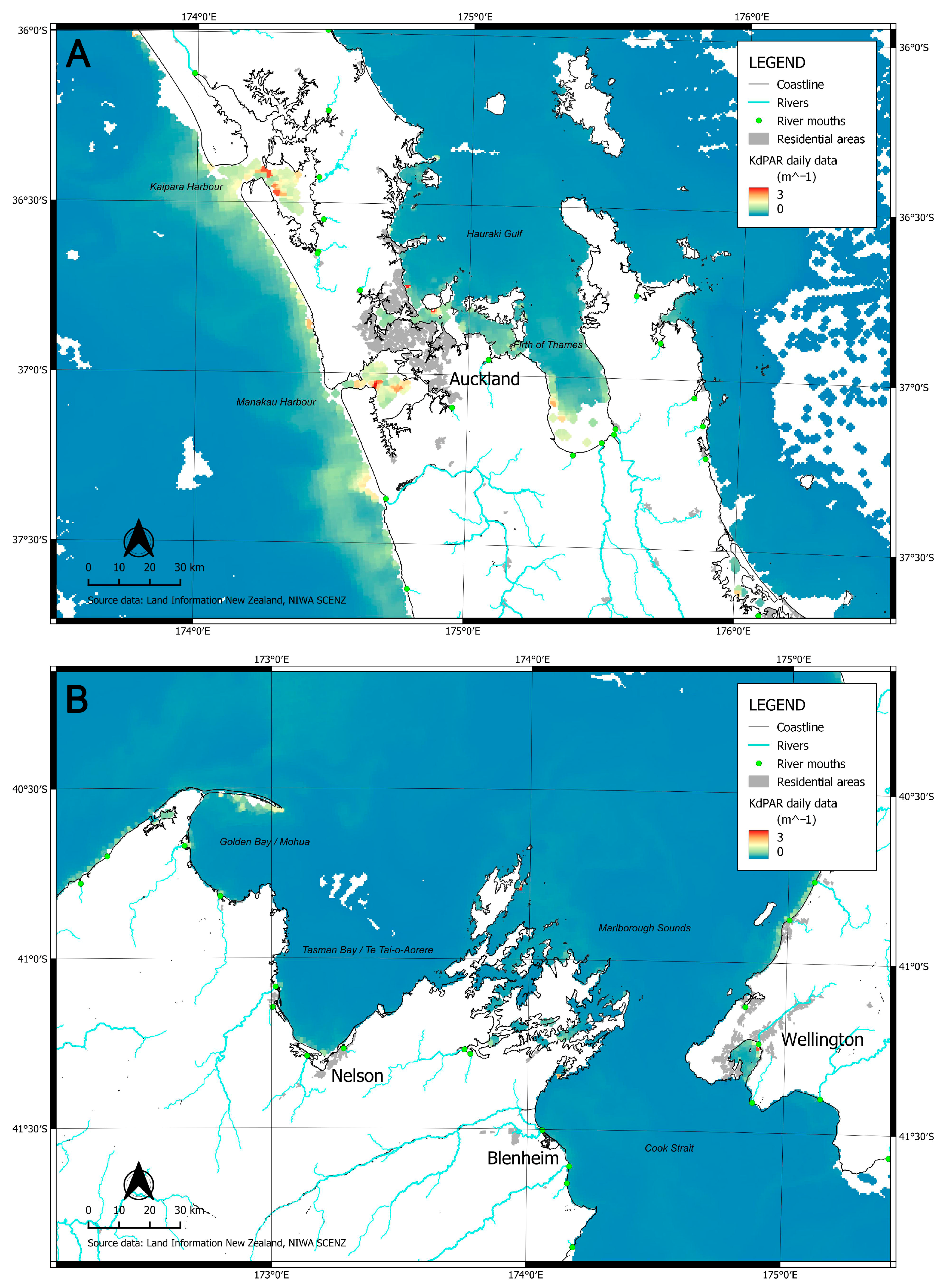

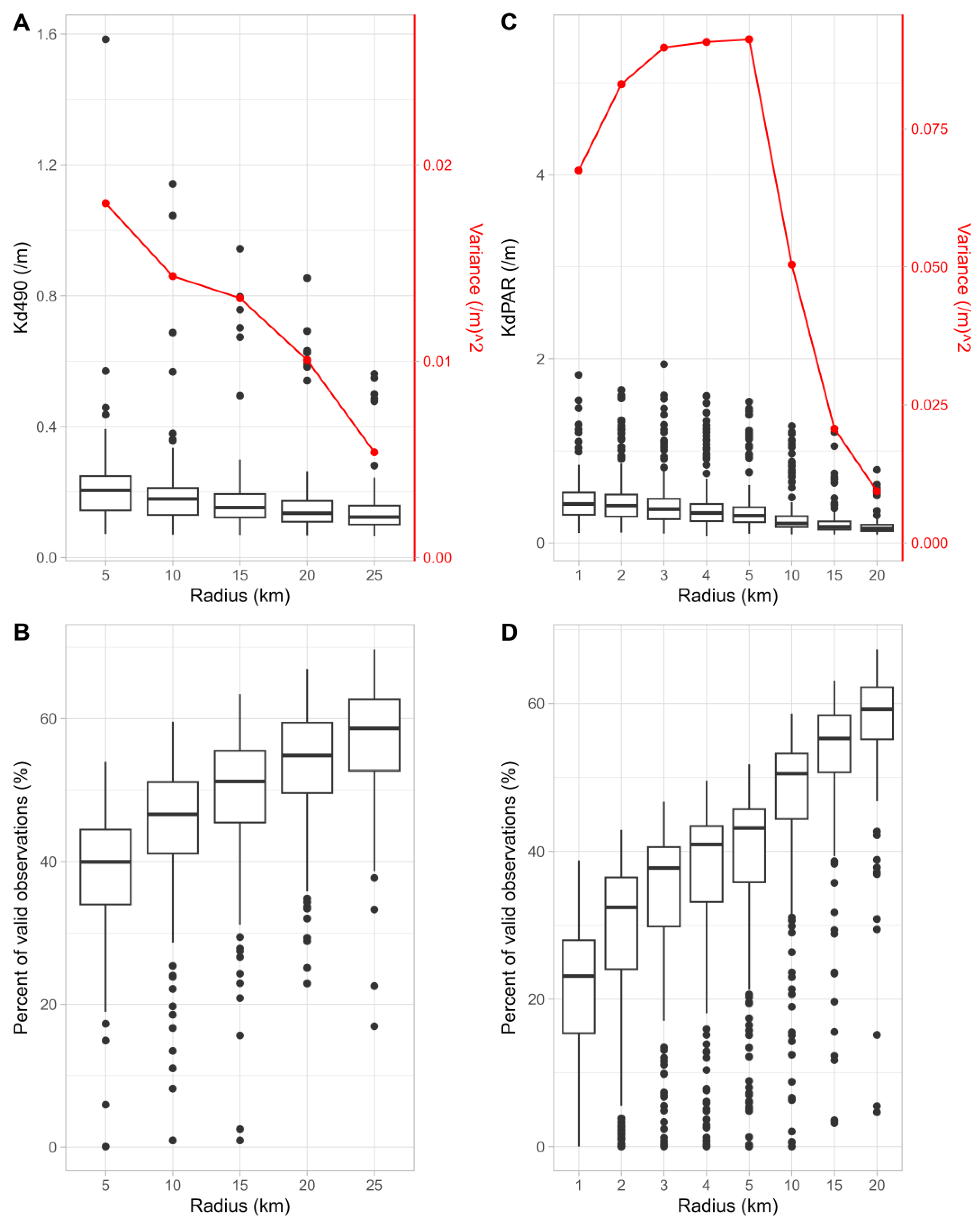
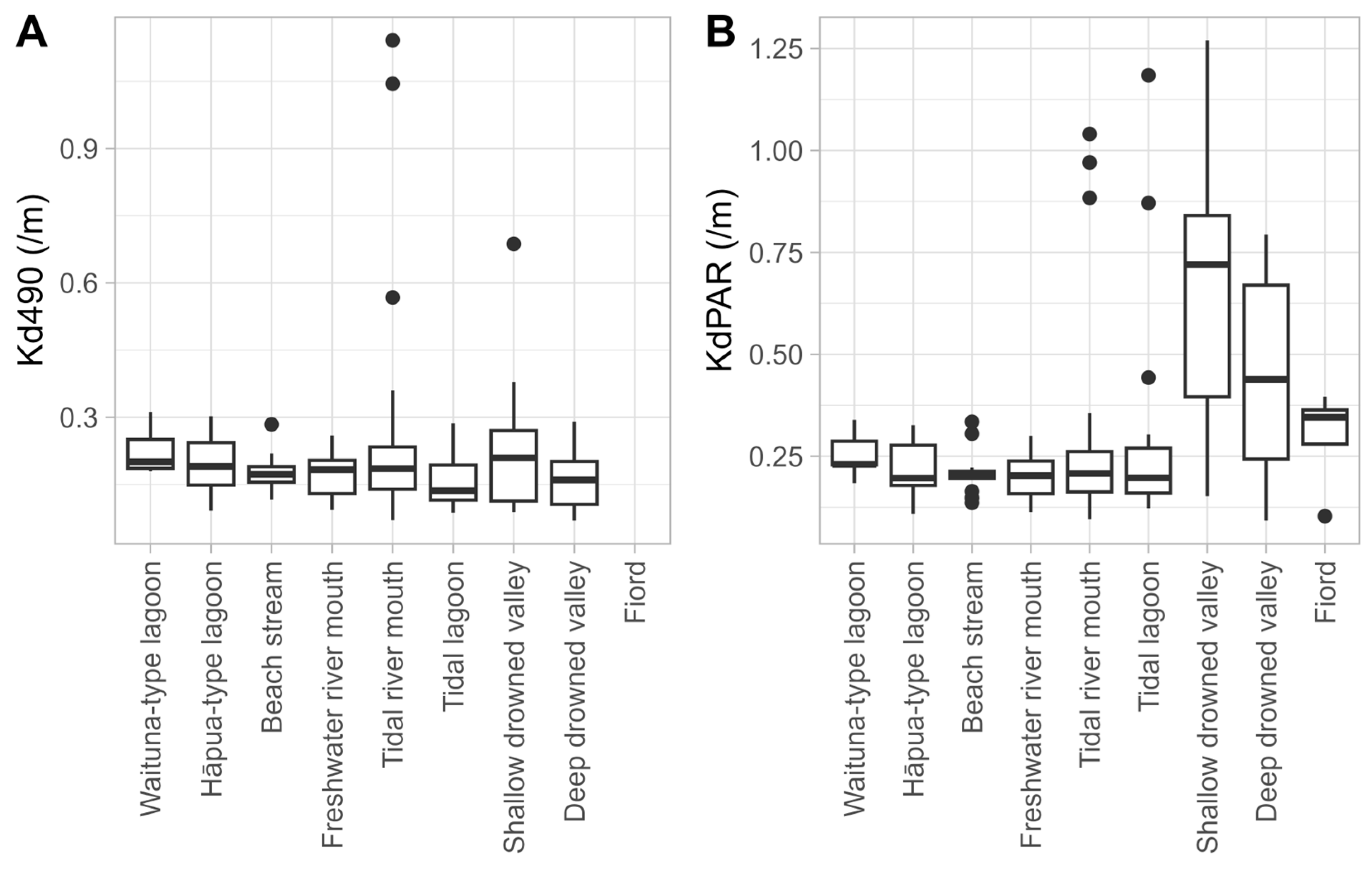
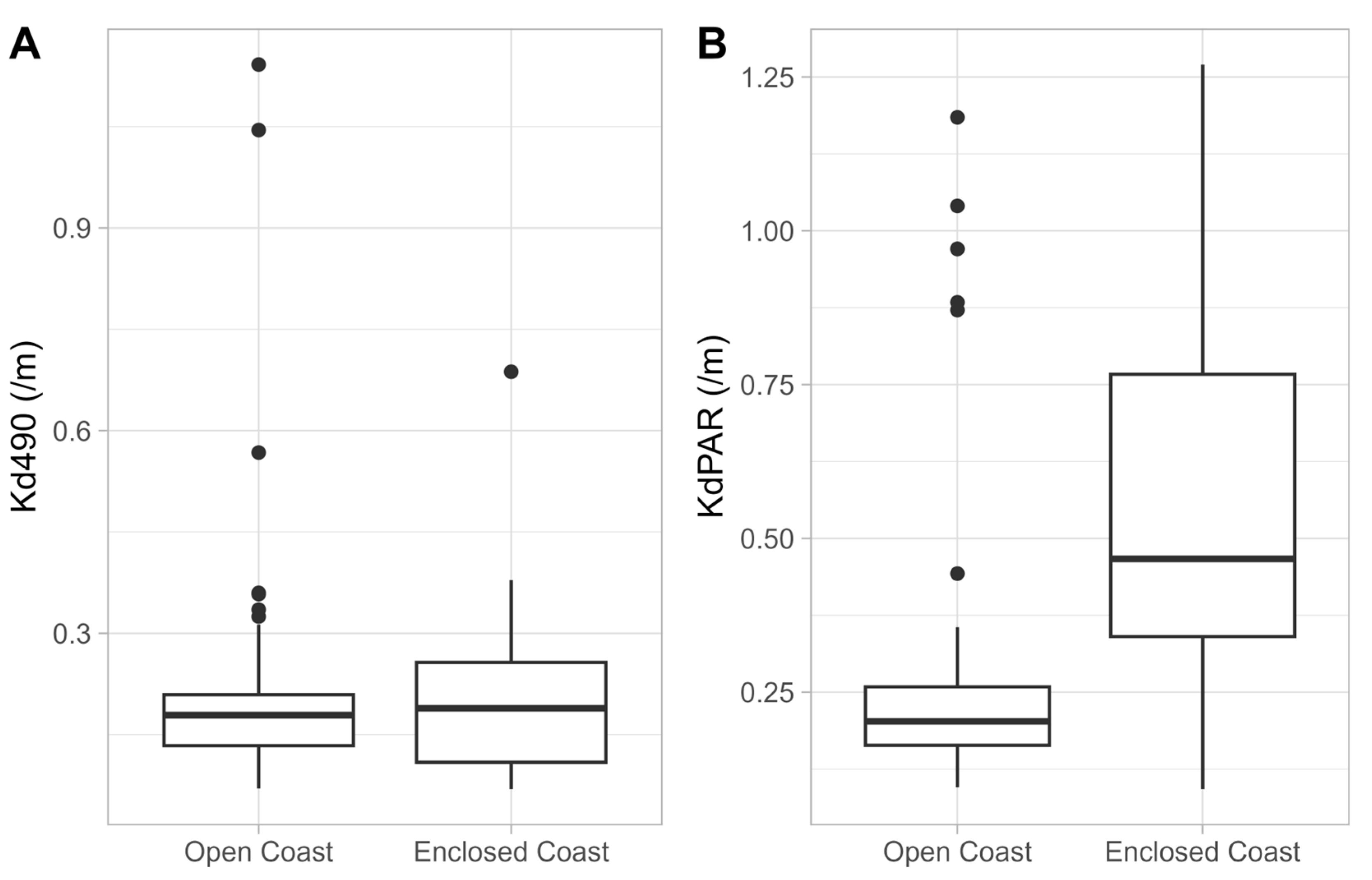


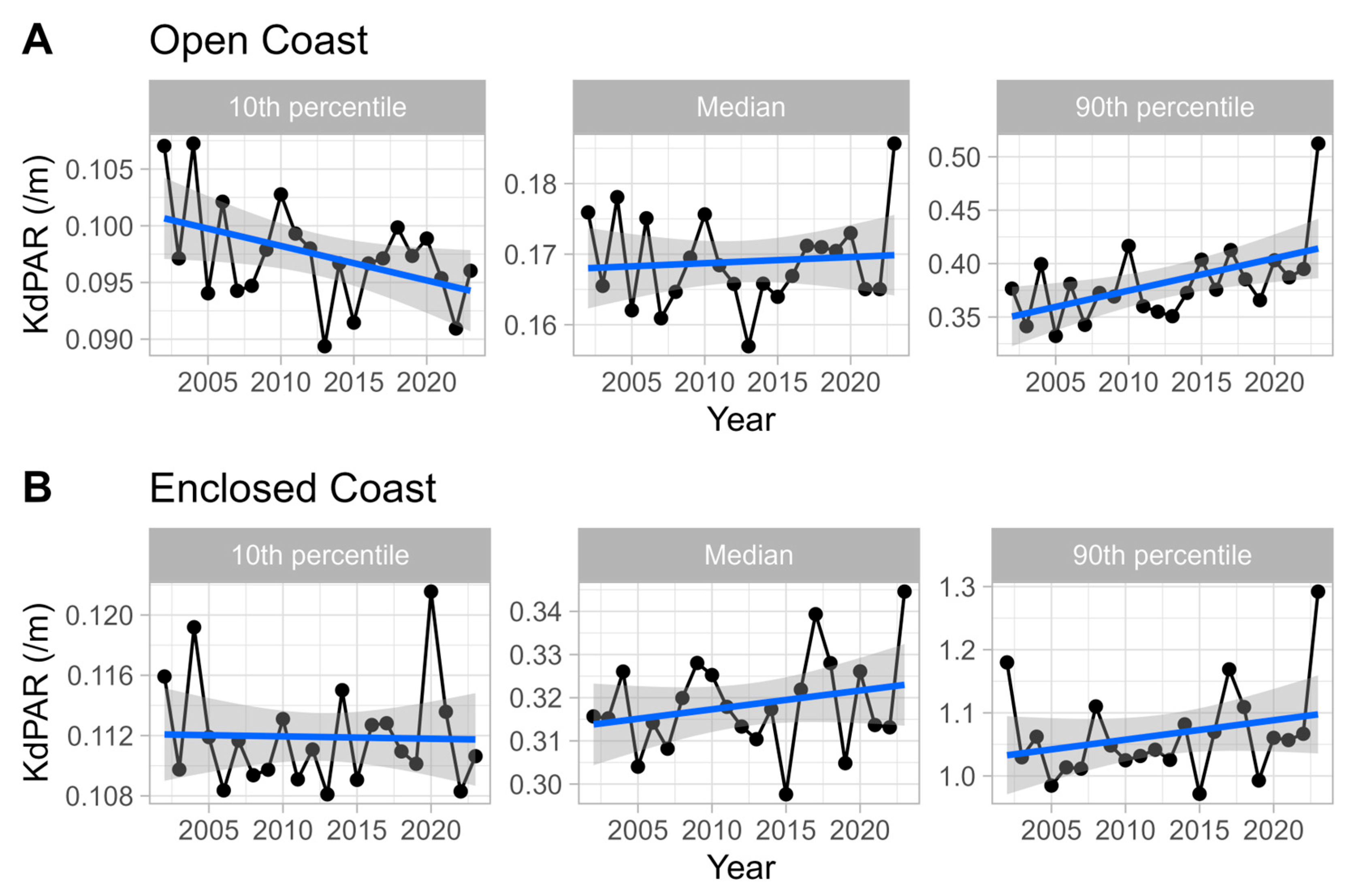
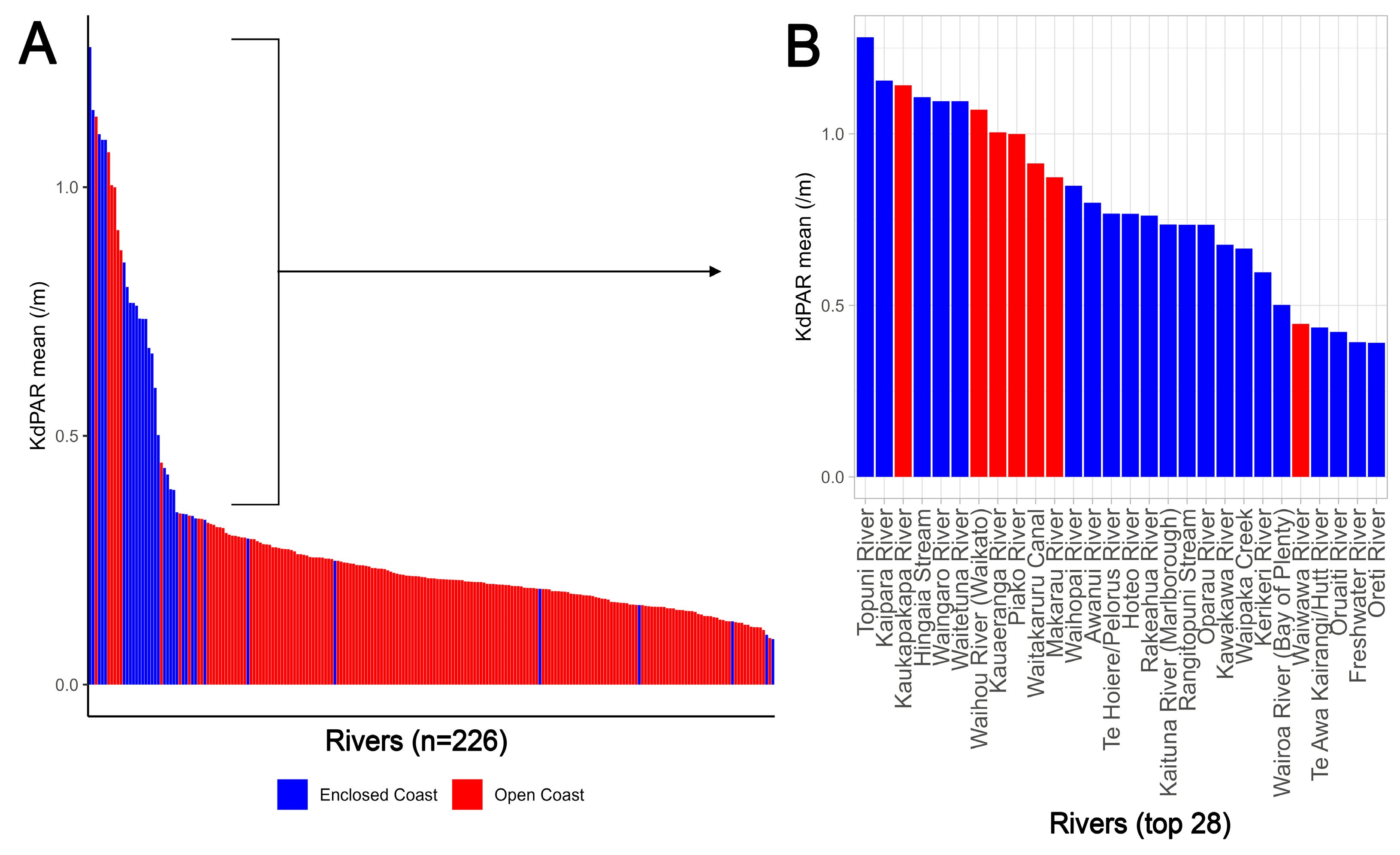
Disclaimer/Publisher’s Note: The statements, opinions and data contained in all publications are solely those of the individual author(s) and contributor(s) and not of MDPI and/or the editor(s). MDPI and/or the editor(s) disclaim responsibility for any injury to people or property resulting from any ideas, methods, instructions or products referred to in the content. |
© 2025 by the authors. Licensee MDPI, Basel, Switzerland. This article is an open access article distributed under the terms and conditions of the Creative Commons Attribution (CC BY) license (https://creativecommons.org/licenses/by/4.0/).
Share and Cite
Orchard, S.; Thoral, F.; Pinkerton, M.; Battershill, C.N.; Ohia, R.; Schiel, D.R. River Radii: A Comparative National Framework for Remote Monitoring of Environmental Change at River Mouths. Remote Sens. 2025, 17, 1369. https://doi.org/10.3390/rs17081369
Orchard S, Thoral F, Pinkerton M, Battershill CN, Ohia R, Schiel DR. River Radii: A Comparative National Framework for Remote Monitoring of Environmental Change at River Mouths. Remote Sensing. 2025; 17(8):1369. https://doi.org/10.3390/rs17081369
Chicago/Turabian StyleOrchard, Shane, Francois Thoral, Matt Pinkerton, Christopher N. Battershill, Rahera Ohia, and David R. Schiel. 2025. "River Radii: A Comparative National Framework for Remote Monitoring of Environmental Change at River Mouths" Remote Sensing 17, no. 8: 1369. https://doi.org/10.3390/rs17081369
APA StyleOrchard, S., Thoral, F., Pinkerton, M., Battershill, C. N., Ohia, R., & Schiel, D. R. (2025). River Radii: A Comparative National Framework for Remote Monitoring of Environmental Change at River Mouths. Remote Sensing, 17(8), 1369. https://doi.org/10.3390/rs17081369







